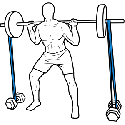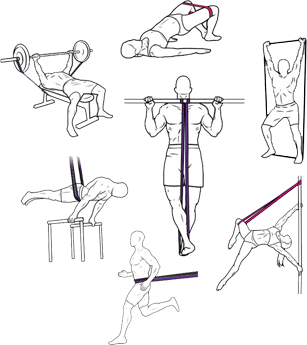Every couple of weeks I'll have someone at my gym sheepishly come up to me and ask about what the "best bodyweight chest exercise" is. My response to them is the response I would give to them should they ask the same question about legs, back or biceps:
"A consistent approach and progressive overload".
Yes, I follow this up with something a lot less confronting and sarcastic- or I wouldn't be helping anybody saying something like that in the slightest. It sounds a little like this:
"So many people are looking for the best exercise, but really all you need to get a bigger (insert body part here) is look at what actions that muscle performs, and perform them with whatever exercise you like. As long as you ensure you do a couple of repetitions more or add an extra half a pound (dependent on the exercise) of resistance each time you return, you will grow over a period and end up where you want to be."
And that is when I take them through the actions their muscle performs, and the variations I tend to enjoy most with the equipment we have on hand.
So, the chest (or pectorals if you want to be a little fancy about it) has two main functions:
1. Brings the shoulder towards the middle of the body (adducts).
2. Turns your shoulder towards the middle of the body (internally rotates the shoulder- turn your elbow pit towards your belly button if you don't understand).
It also moves the scapula anteriorly, but that is a mouthful that it'd struggle to explain in a blog post like this. The point is, if your shoulder joint moves towards the midline of your body, you best believe your chest is the muscle creating that action. To get a full range of motion, we would aim to get a "stretch" by pulling the shoulder blades back and together at the bottom of any chest workout, and finish at the top as I have just laid out for you by bringing the shoulders towards the midline of the body.
If you want to get super technical, there are two "heads" of the chest/pectorals- the clavicular (upper) head and the sternal (lower) head. To train the chest as effectively as possible, you would have to consider the differences in action between these two muscles.
The upper head of the pectoral is attached to the underside of your collarbone and wraps itself into the armpit. I know this is a little technical, but what this means is this if you move your elbow towards the midline of your body and up towards the collarbone you will undoubtedly be using this head of the pectorals.
The same can be said for anything that moves the shoulder and elbow towards the midline of the body, but not upwards towards the collarbone- it will involve the lower head of the pectorals.
So….. There is my (elongated) spiel on what the chest muscles actually do. Now let's look at variations I recommend with the equipment we have on hand. From there, you'll have everything you could ever need to form your own workouts and even create your own exercises, should you wish.
Let's start by assuming you have NO special equipment at all. All you would need for this lot here is a surface to elevate your feet or hands, and you could easily elect to not elevate and still be significantly challenged.
Without any equipment at all I would instantly jump to the push up and its infinite varieties.
For those that cannot currently do a push up, I recommend elevating your hands as much as necessary to create an incline push up. You can also fasten a resistance band to an overhead post (like a pullup bar) and insert the low-lying end around your waist for assisted.
Or, you can wrap the pushup resistance band around your back and grasp the ends in each had for additional resistance as you press through each rep if you need an extra challenge.
The beauty of the incline push up is that you can increase your elevation systematically to know and measure your improvement. It looks something like this:
1. Start with your hands on an elevated surface, arms locked out and legs straight. Keep long from the crown of your head to your heels.
2. Bend at the shoulder and elbow, touch your chest to the surface on which your hands are resting, keeping your shoulder blades together and your shoulders away from your ears.
3. Push the surface your hands are resting on away from you with your hands and spread your shoulder blades while aiming to keep a straight body line.
Other variations I'll often give to my clients who are on their way to their first push up are the bottom up push up, which looks like this:
1. Start with your chest and hands resting on a surface lower than your incline push up. Tighten your body line by tensing your quads, glutes, and abs.
2. Push into the surface on which your chest and hands are resting until your elbows are at a 90-degree bend. Pause and hold for a brief moment and return to the starting position.
And the eccentric isometric push-up, seen below:
1. Start with your hands on a surface lower than your incline push up, arms locked out and legs straight. Keep long from the crown of your head to your heels.
2. Lower down until you hit a 90-degree bend at the elbow and pause in that position. Hold it for as long as possible. Reset and begin again at the top position, counting the total time held in the bottom position (I recommend using a metronome to ensure accurate measurement).
At this point in your journey, I would focus on making the repetition numbers improve along with form, rather than focusing on separating the functions of the upper and lower head of the chest. Train enough to be slightly sore the next day, but capable to perform better 2 or 3 days after your last workout routine. If these numbers continually improve, so will your chest ize and strength. If you can do a few push ups for a few sets, your options open up here a lot. You can elevate your feet, for example, or play with angles and do pike push ups or dive bombers. These angles will involve that upper head due to the elevated feet changing the angle you are playing with.
At this point, you could also play with planche variations as a way to develop the serratus and upper head of the chest. If you want to know more about planche, check out my article on it here.You could also consider doing dips, and play with more advanced push up variations like archer push ups and one arm push ups.
I will highlight something here- consider it a beginner's mistake.
You will get your first decent sets of push up after training for a little while and it will hype you up. YOU DID IT! GO YOU!.... And then you'll think the same about an archer push up or pike push up. And then you'll attempt something you weren't ready for just yet. And maybe injure yourself, or realise it is still a long way off from what you are able to do just now.
Instead of jumping ahead, I recommend making sure your base is really strong. You will still easily grow by upping numbers in your basic and elevated push ups. Yes, it may not be entirely necessary, but it reduces the chances you'll injure yourself and that means more bodyweight training during your life, which means more gains. Hard to argue, there, right? I'm suggesting here, very arbitrarily, that you get to three sets of 12 push ups and slightly elevated push ups before you go chasing things like planche variations, handstand push ups, one arm push ups etc. It just ensures you have some level of strength to begin with.
So now that we have dealt with the equipment-less lot of exercises, let's make things interesting by adding equipment.
As mentioned earlier, the first and easiest thing to address here is that we can add banded resistance to most of these exercises by looking at the direction we are moving in and wrapping a band around whatever follows that direction. For example, a push up has your chest going towards the floor, with the resistance being on the way back up. If we loop a band around our back, it will add resistance to the push up as it tightens more the closer we get to the top of a push up. You can also use our resistance bands as stand-alone tools to develop your chest without performing bodyweight exercises, as seen here. The bands are especially useful in developing planche variations
Next up is the heavy duty parallettes( or lightweight parallettes). These is also a simple enough tool to wrap your head around. They are used to elevate the hands and feet as you progress through push up variations. There are a couple benefits to it though: one being that is can be easier on the wrist than planche on floor for beginners, and the other being that it is portable where whatever else your using might not be able to come with you wherever you go.
The gymnastic rings, however, offer a slew of benefits. They are portable, like the parallettes, can be elevated to any height you need (making progress very easy to measure), are unstable and therefore encourage stability to be created throughout any movement you choose and can simply be used to do things you cannot without them. You open up the possibility to do a ring muscle up, pelican push ups and ring supports- good exercises for chest growth, which without the rings you could not look at the same way. See them below.
So now that we have a healthy menu of chest exercises (only the best, picked just for you), how would you program this?
If you have read any of my blog posts before, the same rules will always apply. I will recommend between three and five working sets, no more than two to three exercises per muscle group per day, and generally between 5 and 15 repetitions. What is different about today's post is that we aren't focusing as closely on strength development, more so on hypertrophy or muscle growth. This means that for the exercises I have mentioned, you are welcome to train between 5 and 30 repetitions provided those repetitions are challenging you by the end of the set.
Personally, I would program 2 exercises of your choice with no more than 10 total working sets for each of those days. I would likely have one that is heavier and more challenging for where you are currently at, and one that is a little less complicated and that you can manage higher repetitions with. Your focus should be doing good quality work for those sets and repetitions and to increase the weight or repetitions in a small and steady way over a long period.
For a beginner that might one day look like this:
Heavy exercise:Eccentric Push Up (2 repetitions, maximum hold) x 3 sets
I would build up to three sets of 2 repetitions that have a combined 30-45 seconds before adding sets or a specific number of reps here.
Light Exercise: Incline Push Up (8-12 repetitions) x 3 sets
I would ensure I have three sets of twelve strong reps before taking the incline to a lower level.
For someone who has a few confident sets of push ups it might look like this:
Heavy exercise: Pelican Push Ups (3 repetitions) x 3 sets
Light Exercise: Decline Push Ups (8-12 repetitions) x 3 sets
Give it a crack. Improve over time. Bust out your bands if you need help. Try not to pop out of your shirts in coming months.
Happy chest days here and forever more!
This article was written in collaboration with Joel Mullen is a duel-degreed an all-rounder trainer, athlete, program designer, and bodyweight training aficionado. Joel specializes in blending bodyweight skills with gymnastics strength training and mobility work.




